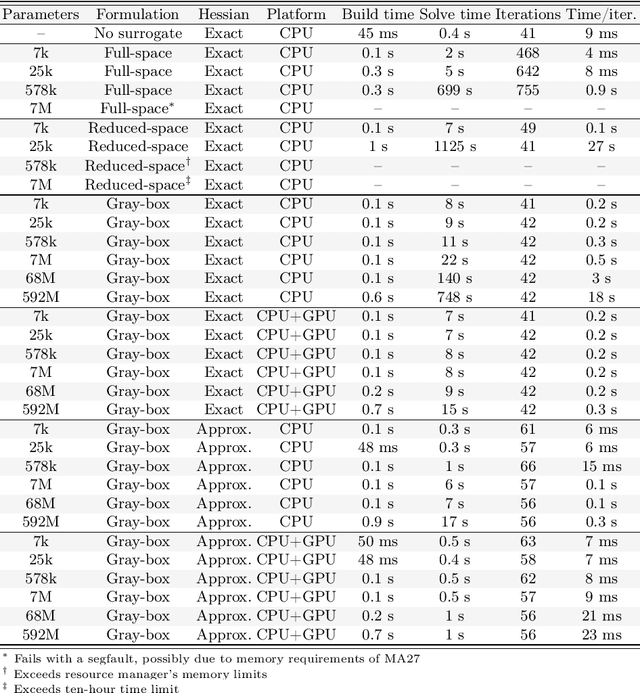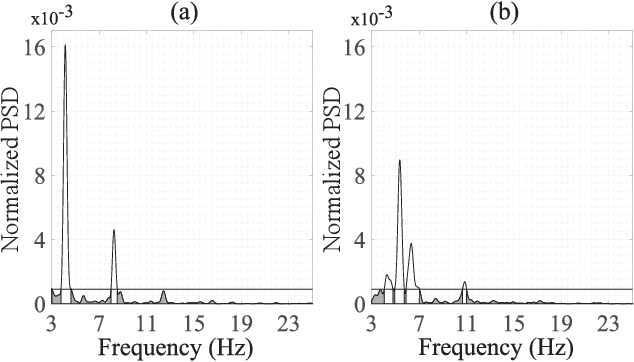Manuel Garcia
Nonlinear Optimization with GPU-Accelerated Neural Network Constraints
Sep 26, 2025Abstract:We propose a reduced-space formulation for optimizing over trained neural networks where the network's outputs and derivatives are evaluated on a GPU. To do this, we treat the neural network as a "gray box" where intermediate variables and constraints are not exposed to the optimization solver. Compared to the full-space formulation, in which intermediate variables and constraints are exposed to the optimization solver, the reduced-space formulation leads to faster solves and fewer iterations in an interior point method. We demonstrate the benefits of this method on two optimization problems: Adversarial generation for a classifier trained on MNIST images and security-constrained optimal power flow with transient feasibility enforced using a neural network surrogate.
Formulations and scalability of neural network surrogates in nonlinear optimization problems
Dec 16, 2024


Abstract:We compare full-space, reduced-space, and gray-box formulations for representing trained neural networks in nonlinear constrained optimization problems. We test these formulations on a transient stability-constrained, security-constrained alternating current optimal power flow (SCOPF) problem where the transient stability criteria are represented by a trained neural network surrogate. Optimization problems are implemented in JuMP and trained neural networks are embedded using a new Julia package: MathOptAI.jl. To study the bottlenecks of the three formulations, we use neural networks with up to 590 million trained parameters. The full-space formulation is bottlenecked by the linear solver used by the optimization algorithm, while the reduced-space formulation is bottlenecked by the algebraic modeling environment and derivative computations. The gray-box formulation is the most scalable and is capable of solving with the largest neural networks tested. It is bottlenecked by evaluation of the neural network's outputs and their derivatives, which may be accelerated with a graphics processing unit (GPU). Leveraging the gray-box formulation and GPU acceleration, we solve our test problem with our largest neural network surrogate in 2.5$\times$ the time required for a simpler SCOPF problem without the stability constraint.
Combination of frequency-and time-domain characteristics of the fibrillatory waves for enhanced prediction of persistent atrial fibrillation recurrence after catheter ablation
Feb 04, 2024Abstract:Catheter ablation (CA) remains the cornerstone alternative to cardioversion for sinus rhythm (SR) restoration in patients with atrial fibrillation (AF). Unfortunately, despite the last methodological and technological advances, this procedure is not consistently effective in treating persistent AF.
A novel wavelet-based filtering strategy to remove powerline interference from electrocardiograms with atrial fibrillation
Jan 23, 2024Abstract:"Objective: The electrocardiogram (ECG) is currently the most widely used recording to diagnose cardiac disorders, including the most common supraventricular arrhythmia, such as atrial fibrillation (AF). However, different types of electrical disturbances, in which power-line interference (PLI) is a major problem, can mask and distort the original ECG morphology. This is a significant issue in the context of AF, because accurate characterization of fibrillatory waves (f-waves) is unavoidably required to improve current knowledge about its mechanisms. This work introduces a new algorithm able to reduce high levels of PLI and preserve, simultaneously, the original ECG morphology. Approach: The method is based on stationary wavelet transform shrinking and makes use of a new thresholding function designed to work successfully in a wide variety of scenarios. In fact, it has been validated in a general context with 48 ECG recordings obtained from pathological and non-pathological conditions, as well as in the particular context of AF, where 380 synthesized and 20 long-term real ECG recordings were analyzed. Main results: In both situations, the algorithm has reported a notably better performance than common methods designed for the same purpose. Moreover, its effectiveness has proven to be optimal for dealing with ECG recordings affected by AF, since f-waves remained almost intact after removing very high levels of noise. Significance: The proposed algorithm may facilitate a reliable characterization of the f-waves, preventing them from not being masked by the PLI nor distorted by an unsuitable filtering applied to ECG recordings with AF."
Time Variability of FibrillatoryWaves Energy Predicts Long-Term Outcome of Atrial Fibrillation Concomitant Surgical Ablation
Jan 19, 2024Abstract:Surgical ablation (SA) is the most effective procedure to terminate atrial fibrillation (AF) in patients requiring concomitant open heart surgery. However, considering the great stress provoked in the patients heart, along with the benefits of anticipating antiarrhythmic therapeutical decisions, preoperative prediction of long term failure of the procedure is an interesting clinical challenge. Hence, the present work introduces a novel algorithm to anticipate SA outcome after one year of follow up by just analyzing the surface ECG. The method firstly extracts fibrillatory waves reflected on standard lead V1 using an adaptive QRST cancellation approach. The resulting signal is then segmented into 1 s length intervals and wavelet energy is computed for all of them. Finally, the coefficient of variation of the time series obtained for the 7th scale is computed. Analyzing 20 second length preoperative ECG excerpts from 53 persistent AF patients undergoing concomitant openheart surgery, only the proposed method reported statistically significant differences between the patients who relapsed to AF and those who maintained sinus rhythm during the follow up. The algorithm also provided values of sensitivity, specificity, and accuracy between 10 and 20% better than the well established dominant atrial frequency and fibrillatory waves amplitude, thus suggesting to be a promising predictor of AF recurrence after SA.
An Efficient Algorithm Based on Wavelet Transform to Reduce Powerline Noise From Electrocardiograms
Jan 19, 2024Abstract:Nowadays, the electrocardiogram (ECG) is still the most widely used signal for the diagnosis of cardiac pathologies. However, this recording is often disturbed by the powerline interference (PLI), its removal being mandatory to avoid misdiagnosis. Although a broad variety of methods have been proposed for that purpose, often they substantially alter the original signal morphology or are computationally expensive. Hence, the present work introduces a simple and efficient algorithm to suppress the PLI from the ECG. Briefly, the input signal is decomposed into four Wavelet levels and the resulting coefficients are thresholded to remove the PLI estimated from the TQ intervals. The denoised ECG signal is then reconstructed by computing the inverse Wavelet transform. The method has been validated making use of fifty 10-min length clean ECG segments obtained from the MIT BIH Normal Sinus Rhythm database, which were contaminated with a sinusoidal signal of 50 Hz and variable harmonic content. Comparing the original and denoised ECG signals through a signed correlation index, improvements between 10 - 72% have been observed with respect to common adaptive notch filtering, implemented for comparison. These results suggest that the proposed method is featured by an enhanced trade-off between noise reduction and signal morphology preservation.
Spectral Distribution Complexity of the Surface Fibrillatory Waves Predicts Post-Catheter Ablation Relapse in Persistent Atrial Fibrillation
Jan 17, 2024

Abstract:As for most of cardiac arrhythmias, atrial fibrillation (AF) is primarily treated by catheter ablation (CA). However, the mid-term recurrence rate of this procedure in persistent AF patients is still limited and the preoperative prediction of its outcome is clinically interesting to select candidates who could benefit the most from the intervention. This context encouraged the study of C0 complexity as a novel predictor, because it estimates organization of the power spectral distribution (PSD) of the fibrillatory waves (f-waves). For that purpose, the PSD was divided into two divergent components using a threshold, theta, which was considered by multiplying the mean value of the PSD by a factor, alpha, ranging between 1.5 and 2.5. On a database of 74 patients, the values of C0 complexity computed for all alpha factors reported statistically significant differences between the patients who maintained sinus rhythm and those who relapsed to AF after a follow-up of 9 months. They also showed higher values of sensitivity (Se), specificity (Sp), and accuracy (Acc) than the well known predictors of the dominant frequency (DF) and f-wave amplitude. Moreover, the combination of the DF and the C0 complexity computed with alpha = 2, via a decision tree, improved classification until values of Se, Sp and Acc of 75.33, 77.33 and 76.58%, respectively. These results manifests the relevance of the f-wave PSD distribution to anticipate CA outcome in persistent AF patients.
 Add to Chrome
Add to Chrome Add to Firefox
Add to Firefox Add to Edge
Add to Edge